|
80x5 -
240x3 -
240x4 -
320x1 -
320x2 -
320x3 -
640x1 -
640x2
Set display option above.
Click on
images to enlarge. |
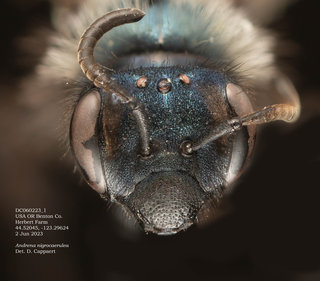
© Copyright source/photographer
· 9
Andrena nigrocaerulea, female, head, DC |
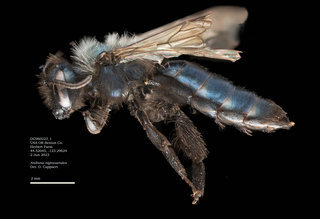
© Copyright source/photographer
· 9
Andrena nigrocaerulea, female, lateral, DC |
|
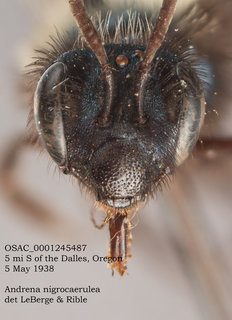
David Cappaert · 8
Andrena nigrocaerulea, female, head, OSAC |
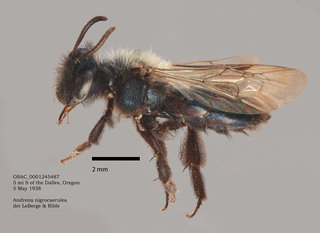
David Cappaert · 8
Andrena nigrocaerulea, female, lateral, .OSAC |
|
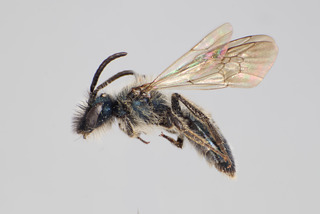
© Copyright Laurence Packer 2014
· 7
Andrena nigrocaerulea MALE CFP- |
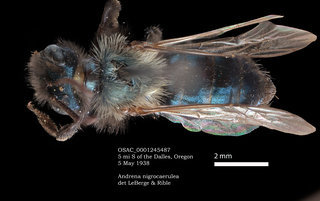
David Cappaert · 5
Andrena nigrocaerulea, female, dorsal, OSAC |
|
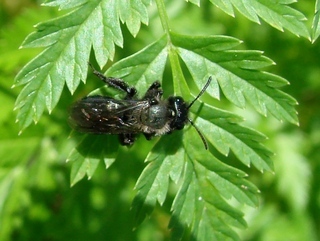
© Copyright John Ascher, 2006-2014
· 3
Andrena nigrocaerulea, Blue-and-black Andrena |
|
Overview |
Reprinted with permission of the American Entomological Society from:
LaBerge, W. E., Ribble, D. W. 1975. A revision of the bees of the genus Andrena of the Western Hemisphere. Part VII. Subgenus Euandrena. Transactions of the American Entomological Society 101: 371-446.
Please report text errors to: leah at discoverlife dot org.
The female of A. nigrocaerulea is readily distinguished from related species by the extensive dark body hairs, the complete lack of apical metasomal fasciae, the usually punctate and often shiny clypeus, and the metallic blue-black color of the integument. Sometimes the male of nigrocaerulea is very difficult to separate from that of A caerulea. The longer facial quadrangle and the longer, broader vannal lobe of the hind wing are the best characters to distinguish nigrocaerulea from caerulea. Several other characters when taken together will usually separate these males without pulling out the mouthparts. In addition to the longer facial quadrangle, nigrocaerulea has the integument shinier, darker blue and more coarsely roughened on the propodeum; the clypeus longer, with more distinct punctures and darker violaceous reflections; the face with more dark hairs and the body hairs rarely yellow (as in some northern caerulea); and the general size larger. Many, if not most, specimens of nigrocaerulea have an unshagreened, shiny clypeus and for this reason are easily separable from caerulea in either sex. These males are similar to those of lawrencei from which they can be readily separated by their smaller size and shorter vertex.
FEMALE. MEASUREMENTS AND RATIOS. — N = 20; length, 10-12 mm; width, 2.5-3.5 mm; wing length, 3.37 ± 0.180 mm; FL/FW, M = 1.08 A 0.005; FOVL/FOVW, M = 4.35 ± 0.092.
INTEGUMENTAL COLOR. — Metallic bluish-black except as follows; mandible as in lawrencei; scape black or brownish-black below; clypeus with violaceous reflections basally (usually weak); wing membranes moderately infumate, brownish, veins brownish-black; tegulae dark; legs dark brownish-black to black, tibia! spurs dark amber to black; sterna brownish-black.
STRUCTURE. — antennal scape as long as first four flagellar segments; first flagellar segment slightly longer than segments 2 plus 3, segment 2 about equal in length to 3, broader than long; segments 4-9 quadrate. Eyes each about four times as long as broad, inner margins converging towards mandibles. Mandible as in lawrencei. Galea as in lawrencei but shorter, more pointed and usually shinier. Maxillary palpus as in lawrencei but shorter and segmental ratio about as 0.6:1.0:0.7:0.7:0,6:0.7. Labial palpus as in lawrencei but shorter and ratio about as 1.0:0.7:0.6:0.C). Labrum much as in lawrencei , process not emarginate. Clypeus elongate, at apex sides nearly parallel, rounded from side to side, punctures large and only partially obscured by fine reticular shagreening, often shagreened only basally. Supraclypeal area, face above antennal fossae, facial foveae, and genal area as in lawrencei. Vertex above lateral ocellus usually equal to about one ocellar diameter, sculptured as in lawrencei.
Thoracic structure and sculpturing as in lawrencei except as follows; propodeum and mesepisternum with sculpturing often coarser; hind wing with vannal lobe normal, broad, at excision one and one-half to two times as broad as end of cell Cu; hind tibia only slightly widened apically.
Metasomal structure and sculpturing as in lawrencei but terga often with finer shagreening or shagreening partially absent, terga often shiny; pygidial plate V-shaped, acute at apex, lateral margins not upturned, median internal ridge not evident or not sharply raised, rounded.
VESTITURE. — Hairs dark, brownish-black to black except thoracic dorsum with white hairs and tergum 1 with some white hairs, often with pale hairs surrounding antennal bases. Propodeal corbicula incomplete anteriorly with many, long, simple, internal hairs. Tibial scopal hairs long, usually simple (rarely weakly plumose but plumosity obscured by dark color of hairs), curving posteroventrally. Hind femur with hairs normal, weakly plumose to highly plumose. Hind trochanter as in nigrihirta. Metasomal terga with apical fasciae entirely absent, otherwise as in nigrihirta.
MALE. MEASUREMENTS AND RATIOS. — N = 20; length, 7-11 mm; width, 2-3 mm; wing length, 3.12 ± 0.140 mm; FL/FW, M = 1.11 ± 0.005; FS1/FS2, M = 1.47 ± 0.033.
INTEGUMENTAL COLOR. — Black with bright metallic blue reflections including clypeus, metasomal sterna with blue-black reflections. clypeus with weak violaceous reflections. Wing membranes yellowish-brown, veins dark. Color otherwise as in female.
STRUCTURE. — Antennae as in lawrencei but scape length equal to about first two and one-third flagellar segments and flagellar segment 1 much shorter than segments 2 plus 3. Eyes each about three and one-half times as long as broad, inner margins converging strongly toward mandibles. Mandible and galea as in female. Maxillary palpus as in female but segmental ratio about as 1.0:1.0:0.9:.0.8:0.8:0.9. Labial palpus as in female but ratio about as 1.0:0.6:0.6:0.6. Labrum as in lawrencei but only occasionally weakly emarginate apically. Clypeus as in female. Supraclypeal area and genal area as in lawrencei. Face above antennal fossae as in nigrihirta but often slightly more coarsely rugulate. Vertex as in nigrihirta but usually taller, above lateral ocellus always equal to at least one ocellar diameter.
Thoracic form and sculpturing as in nigrihirta except as follows: propodeum slightly more coarsely sculptured; hind wing with vannal lobe as broad as in female.
Metasoma as in nigrihirta except terga 2-5 often shiny, with shagreening fine or partially absent.
Terminalia as in figures 13-17; note the following: genital capsule similar to nigrihirta but gonostylus more rounded apically and dorsal lobe gonocoxite extremely short; sternum 8 not distinctly enlarged at apex.
VESTITURE. — Much as in lawrencei but thorax without dark hairs; metasomal with apical fasciae absent; face usually with abundant black or dark brown hairs.
VARIATION. — Andrena nigrocaerulea exhibits uncorrelated variation in three characteristics. The color varies from bright blue-black to black throughout the range of the species. In Oregon and Washington some specimens are more greenish or greenish-gold than blue. The clypeus may be unshagreened (except narrowly along the posterior margin) and shiny or entirely shagreened slightly obscuring the deep punctures. Both conditions and intermediate states can be found throughout the range of the species. The clypeus varies from long to very long (see measurements of both sexes for mean and standard error of facial length/width). Specimens of either sex with short facial foveae may overlap in this character specimens of caerulea with relatively long facial quadrangles but better than 90% of the specimens can be clearly distinguished by use of this character alone. The shorter faced individuals of nigrocaerulea seem to be absent from the San Francisco Bay area where both nigrocaerulea and caerulea are most abundant. This may be a case of incipient character displacement.
|
|
|
Names | |
|
|
| Supported by | |
Updated: 2024-04-16 17:15:39 gmt
|